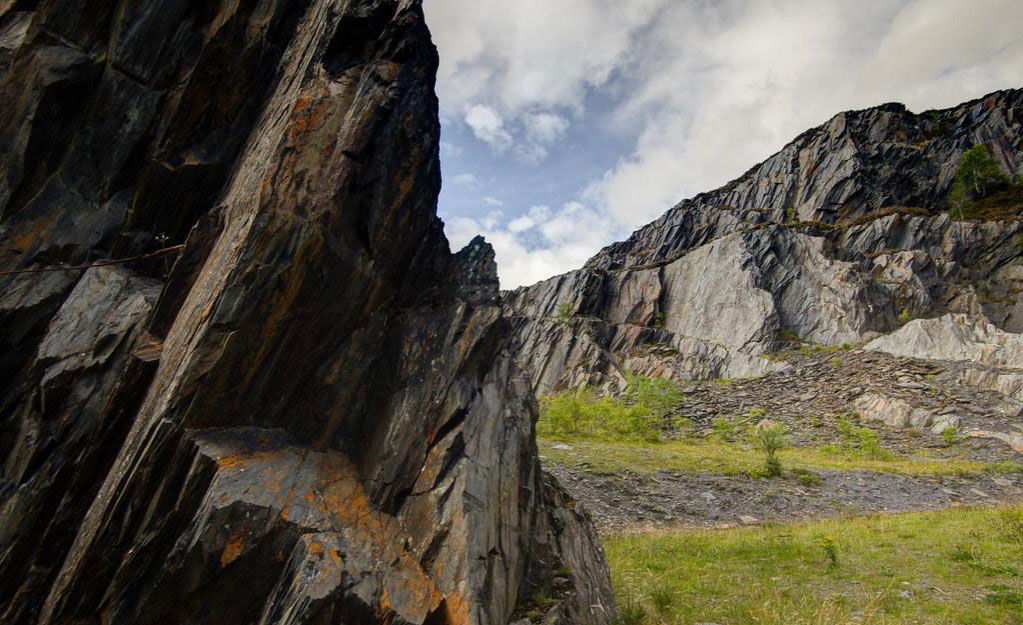Slate is one of the most widely used building materials in Scotland. It is particularly well known for its use as a roof covering on many traditional Scottish buildings, and has been used for this purpose for centuries. It varies in colour and texture depending on where it has been quarried, but is predominantly grey blue in colour. Slate is found globally, and in other areas of the UK, but Scottish slate is distinct in that it generally has a rougher texture and is thicker and more irregular than that found in other areas.
Slate is a fine-grained metamorphic rock that cleaves, or splits, easily into thin sheets that have great tensile strength and durability. As with all rock and stone, it is the product of millions of years of geological changes and was formed under low-grade metamorphic conditions (i.e. under relatively low temperature and pressure).
It has a very low rate of water absorption, which makes it waterproof and resistant to frost and freezing. It is fire resistant and extremely durable, and can last centuries with little to no maintenance.
Slate quarries were once abundant and could be found across Scotland. At their peak in the 19th century, there were thought to be around 80 slate quarries across Scotland, around 30 of these would have been commercial queries with the rest linked to crofting. By the early 1800s the Scottish slate industry was focused mainly on:
Although slate is still present in Scotland, there are no longer any working quarries in the country. The Macduff and Foundland quarries closed in 1870, with the rest of Scotland’s slate quarries closing by the mid-1950s. The only Scottish slate that is still available today is recycled slate, but there is a strong second-hand market which shows the strength and durability of the material.

Slate is predominantly used as an architectural building material. It is most commonly used as a roofing material, replacing thatch as the most widely used roofing material in the 17th and 18th centuries as it is non-flammable and durable. It can also be used as a flooring material, although these can be slippery when wet, and as cladding for walls. Historically, slate was also used in schools for blackboards and individual writing slates which were written onto using chalk.

On a smaller scale, slate can also be used to create sculptures for gardens and can even be used to create jewellery! Stefanie Cheong is a Scottish Designer/Maker who creates jewellery and art objects using recycled metals paired with rocks found and collected from across Scotland. She combines traditional stone cutting techniques with a contemporary aesthetic to harness the natural beauty of these found rocks, and many of her jewellery pieces are interchangeable. One of the rocks she commonly uses is slate collected on Easdale Island, where one of Scotland’s historical slate quarries was once situated.
Although slate is still present in Scotland, there are currently no slate quarries in operation.
Before the closure of the Scottish slate quarries, Ballachulish, near Loch Leven in the Highlands, was the largest slate quarry in the country – producing around 25 million slates per year by the mid-1800s. Slate production in Scotland peaked in 1895 when they produced a combined total of 45,000 tonnes of slate, around 8% of the UK total. Less than 20 years later, by 1914, their output had dropped to only 8,000 tonnes annually. Many of the quarries ceased operation practically overnight at the start of the First World War, and their output continued to dwindle throughout the first half of the 20th century with the last remaining quarries closing in the mid-1950s.
Scotland’s slate industry dwindled due to:
The slate produced in Scotland was unique in that it was generally thicker than that found in the rest of the UK, and irregularly sized. While this contributed to it’s longevity and made it somewhat distinctive, the rest of the UK preferred slates that were regularly sized and the Scottish quarries, which weren’t as mechanised as those in England and Wales, weren’t able to deliver regular sizes.
Nowadays, the majority of slate used for new buildings in the country is imported from the rest of the UK or overseas. There is also a market for second-hand Scottish slate which has been removed from older buildings, particularly for the use in maintenance of traditional and historical buildings.
In terms of sustainability, slate is a finite material but one which has a very long lifespan – even with little maintenance. This is demonstrated by the fact that so many buildings in Scotland are still roofed with Scottish slate despite the last quarries closing over 60 years ago. Many of these slate roofs have lasted for over 100 years, and are still going strong. Supplies for replacement in older buildings are very limited, but the long lasting nature of slate means that when a building reaches the end of it’s lifespan the slates should be removed and reused wherever possible.
“Building Materials: Slate”. The Engine Shed, https://www.engineshed.scot/building-advice/building-materials/slate/#overview. Accessed 19th February 2021.
Bushell, Natalie. “The Rise and Demise of Scotland’s Historic Slate Industry”. The Engine Shed Blog, https://blog.engineshed.scot/2020/04/17/scottish-slate-industry/. Accessed 19th February 2021.
Korn, Elena. “The Origins of Natural Stone: Where Does Slate Come From?”. Natural Stone Online, https://www.naturalstone.co.uk/blogs/news/the-origins-of-natural-stone-where-does-slate-come-from. Accessed 19th February 2021.
“Slate”. Britannica Encyclopedia, https://www.britannica.com/science/slate-geology. Accessed 19th February 2021.
“About”. Stefanie Cheong, https://www.stefaniecheong.co.uk/about. Accessed 19th February 2021.